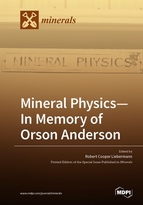Mineral Physics—In Memory of Orson Anderson
A special issue of Minerals (ISSN 2075-163X). This special issue belongs to the section "Crystallography and Physical Chemistry of Minerals & Nanominerals".
Deadline for manuscript submissions: closed (31 January 2020) | Viewed by 157685
Special Issue Editor
Interests: elasticity of minerals at high pressure and temperature; ultrasonic interferometry; multi-anvil, high-pressure apparatus; synchrotron X-radiation
Special Issue Information
Dear Colleagues,
This Special Issue is dedicated to Professor Orson L. Anderson on the occasion of his 95th birthday. This Special Issue is planned to include a representative group of experimental and theoretical papers in the field of mineral physics (and also rock physics).
Mineral physics is the study of mineralogical problems through the application of condensed matter physics. In reality, mineral physicists use not only physics, but also solid-state chemistry; they study not only minerals, but all materials related to natural minerals (e.g., structural analogs, but also glasses, melts and fluids).
We welcome contributions from all practitioners of this scientific discipline.
Please confirm your interest in submitting a paper directly to the Guest Editor.
Prof. Dr. Robert Cooper Liebermann
Guest Editor
Manuscript Submission Information
Manuscripts should be submitted online at www.mdpi.com by registering and logging in to this website. Once you are registered, click here to go to the submission form. Manuscripts can be submitted until the deadline. All submissions that pass pre-check are peer-reviewed. Accepted papers will be published continuously in the journal (as soon as accepted) and will be listed together on the special issue website. Research articles, review articles as well as short communications are invited. For planned papers, a title and short abstract (about 100 words) can be sent to the Editorial Office for announcement on this website.
Submitted manuscripts should not have been published previously, nor be under consideration for publication elsewhere (except conference proceedings papers). All manuscripts are thoroughly refereed through a single-blind peer-review process. A guide for authors and other relevant information for submission of manuscripts is available on the Instructions for Authors page. Minerals is an international peer-reviewed open access monthly journal published by MDPI.
Please visit the Instructions for Authors page before submitting a manuscript. The Article Processing Charge (APC) for publication in this open access journal is 2400 CHF (Swiss Francs). Submitted papers should be well formatted and use good English. Authors may use MDPI's English editing service prior to publication or during author revisions.






